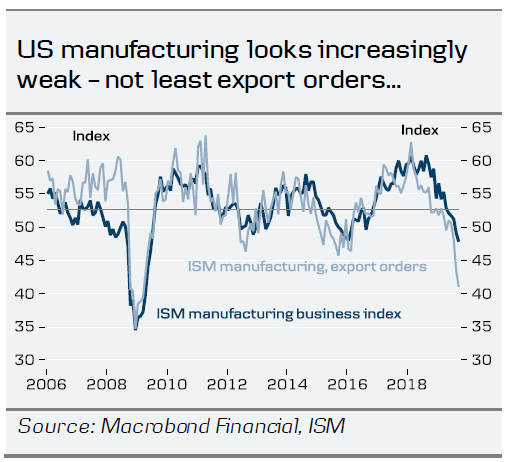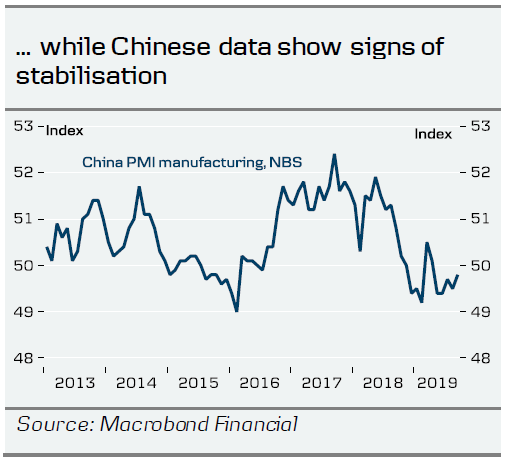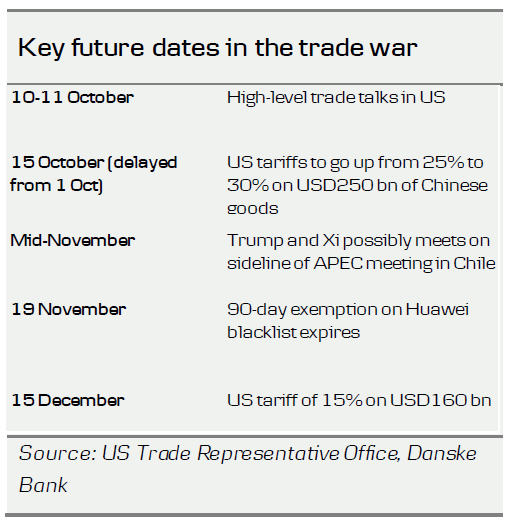- US and China meet for high-level trade negotiations next week, sources say 10-11 October. Below is a quick overview.
- We put a 60% probability of an interim trade deal, which should help to de – escalate the trade war. However, the road to a big deal is still paved with many obstacles in our view.
- An interim deal should be positive for risk sentiment in the short term.
Who will meet?
A US delegation led by US Trade Representative Robert Lighthizer and US Treasury Secretary Stephen Mnuchin will meet for the 13th round of high-level negotiations with their Chinese counterpart in the trade war. The Chinese delegation will be led by Vice – Premier Liu He, Xi Jinp ing’s right-hand man when it comes to economics and financial issues. The vice-premier is expected to be joined by other top officials, among others the Commerce Minister Zhong Shan, who became part of the core of the Chinese negotiation team after the break-down in May. He was generally seen as a hawkish addition to the trade team. Last y ear during the trade war he said that the US “don’t know the history and culture of China” and “The US should not underestimate China’s resolve and will”.
What are the odds of an interim deal?
We see a more than 50-50 chance that the talks end with a small interim deal, as both sides seem to have an interest in striking such a deal (we put the probability at 60%).
On the US side, there is a rising concern over the weakening of the US economy heading into the Presidential election year in 2020. This week US ISM manufacturing showed another sharp drop in activity with export orders being particularly weak (see chart). Politico wrote in Sep tember that Trump ‘s advisers are looking for an escap e hatch out of the tariff hikes Trump has coming in mid-October and in December (see table). With limited ways to boost the economy through fiscal policy and monetary policy in the hands of the Fed, the White House has few tools to keep the economy strong next year. Tariff hikes would work as a further drag and increasingly hurt the one pillar that is holding up the economy, the US consumer. M aking a deal with China allowing Trump to pull back the tariff hikes and even get something in return from China looks to be a favourable outcome. It comes with a price, though: Trump reduces the pressure on China by taking tariff hikes off the table, something he may not like. But he still might favour it over a further weakening of the economy.
On the Chinese side, there has been concern over Trump’s temper and if he could in effect escalate tensions (which it looked like in early August when he retaliated in response to China’s retaliation). To show goodwill by buying US agriculture again could work to calm Trump down and reduce the risk of another bout of escalation. China has already bought a considerable amount of US soy beans and pork ahead of the trade talks according to the Ministry of Commerce in China. There is no doubt that agriculture is one of the strongest cards China is holding in the trade war. Many US farmers are hurting badly from China halting their purchases, and flooding in some areas this year has only added to the pain. Listening to interviews with farmers, they generally support Trump standing up to China, but the pain is growing and many express impatience with the deal. On top of the short-term pain, there is a growing concern that farmers will never get back their strongest growth market, which they have worked on for many years to build up.
What would an interim deal look like?
As suggested above, the cornerstone of an interim deal would be China buying US agriculture again. In exchange, Trump would, as a minimum, have to postpone the announced tariff increases on 15 October and 15 December. The question, though, is how much China would buy and how much they will demand in return. This is why it may not be all smooth sailing. China would be reluctant to completely return to full-scale purchases and give away their strongest card unless they got some serious concessions in return. A compromise could be (unofficially) that China buys for a certain period of time and a continuation of purchases would be conditioned on a further roll-back of tariff rates. It easily gets a bit speculative, as we don’t know exactly what is on the table. But agriculture and tariff relief is likely to be part of an interim deal in some way.
Intellectual Property Rights (IPR) have also been mentioned as a possible ingredient in a deal. If so that would be positive, as it is where the two sides have struggled. We believe China is of the view that they have already done enough to tighten protection of IPR through a law earlier this year, that, among other things, increases punishments for infringement of IPR significantly. Trump could choose to be satisfied with this and write it into the deal and take the credit for it.
Conclusion: An interim deal to underpin risk assets in the short term
We expect an interim deal to underpin risk assets in the short term. An interim deal would to some extent be a sign that Trump has a fairly low pain threshold and reduce the tail risk of a much further escalation. What happens on the other side of an interim deal will depend on whether the new ‘ceasefire’ stay s longer than a month this time and whether the two sides move any closer to a real deal. We believe the latter is much more difficult as China is, in our view, unlikely to give many inches from where it ended in early May. They had to backtrack because of internal resistance in China to the deal that was on the table. That resistance will not go away because the deal was seen as a breach of Chinese sovereignty and triggered reminders of the ‘unequal treaties’ following the Opium wars in the 19th century. The US side, on the other hand, will struggle to settle for a smaller deal than what they had in sight before the talks broke down. In our view this deadlock will be very difficult to break.















